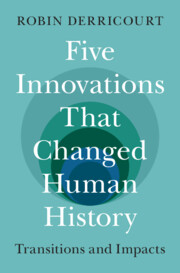150 results
Chapter 20 - Fatwās on Aspects of Modern Life
- from Part III - Legal Opinions (Fatwās)
-
-
- Book:
- Islamic Law in Context
- Published online:
- 14 November 2024
- Print publication:
- 21 November 2024, pp 214-222
-
- Chapter
- Export citation
Chapter 6 - Communicating Wirelessly
-
- Book:
- Five Innovations That Changed Human History
- Published online:
- 01 November 2024
- Print publication:
- 21 November 2024, pp 187-234
-
- Chapter
- Export citation
Ultra-processed food consumption is related to screen time among Brazilian adolescents, adults and older adults
-
- Journal:
- British Journal of Nutrition / Volume 133 / Issue 1 / 14 January 2025
- Published online by Cambridge University Press:
- 11 November 2024, pp. 118-125
- Print publication:
- 14 January 2025
-
- Article
-
- You have access
- Open access
- HTML
- Export citation
Wer Viewership and Queer Imag(in)ing: Thai Soap Opera Shadow of Love and Boys Love Media
-
- Journal:
- TRaNS: Trans-Regional and -National Studies of Southeast Asia , First View
- Published online by Cambridge University Press:
- 11 November 2024, pp. 1-15
-
- Article
-
- You have access
- HTML
- Export citation

Five Innovations That Changed Human History
- Transitions and Impacts
-
- Published online:
- 01 November 2024
- Print publication:
- 21 November 2024
Job Talk: Candidate Gender and Presentation of Prior Experience in Television Ads in the US
-
- Journal:
- Politics & Gender / Volume 20 / Issue 4 / December 2024
- Published online by Cambridge University Press:
- 30 September 2024, pp. 814-833
-
- Article
-
- You have access
- Open access
- HTML
- Export citation
“My Army Family”: Civil-Military Representation in Military-Sponsored Television Content in Pakistan
-
- Journal:
- Critical Pakistan Studies / Volume 1 / Issue 1-2 / May 2023
- Published online by Cambridge University Press:
- 19 September 2024, pp. 206-237
-
- Article
-
- You have access
- Open access
- HTML
- Export citation
4 - The B Word
-
- Book:
- Bitch
- Published online:
- 13 June 2024
- Print publication:
- 27 June 2024, pp 98-130
-
- Chapter
- Export citation
Chapter 22 - The Young People’s Concerts
- from Part IV - Bernstein as Musical and Cultural Ambassador
-
-
- Book:
- Leonard Bernstein in Context
- Published online:
- 06 April 2024
- Print publication:
- 28 March 2024, pp 183-189
-
- Chapter
- Export citation
Chapter 40 - Cultural Icon
- from Part VI - The Legacy
-
-
- Book:
- Leonard Bernstein in Context
- Published online:
- 06 April 2024
- Print publication:
- 28 March 2024, pp 339-347
-
- Chapter
- Export citation
Chapter 37 - Major Writings
- from Part VI - The Legacy
-
-
- Book:
- Leonard Bernstein in Context
- Published online:
- 06 April 2024
- Print publication:
- 28 March 2024, pp 314-321
-
- Chapter
- Export citation
Navigating nuclear narratives in contemporary television: The BBC’s Vigil
-
- Journal:
- Review of International Studies / Volume 50 / Issue 6 / November 2024
- Published online by Cambridge University Press:
- 19 January 2024, pp. 987-1003
- Print publication:
- November 2024
-
- Article
-
- You have access
- Open access
- HTML
- Export citation
Mothers’ experiences of reducing family mealtime screen use in Australian households with young children
-
- Journal:
- Public Health Nutrition / Volume 27 / Issue 1 / 2024
- Published online by Cambridge University Press:
- 15 December 2023, e21
-
- Article
-
- You have access
- Open access
- HTML
- Export citation
Chapter 11 - Romeo and Juliet, Again and Again: Star-Crossed Lovers Adapted to Serial Television
- from Part III - Serial and Queer Romeo and Juliets
-
-
- Book:
- Shakespeare on Screen: Romeo and Juliet
- Published online:
- 10 October 2023
- Print publication:
- 14 December 2023, pp 171-184
-
- Chapter
- Export citation
Chapter 16 - Romeo and Juliet on Screen: Select Film-bibliography
- from Part III - Serial and Queer Romeo and Juliets
-
-
- Book:
- Shakespeare on Screen: Romeo and Juliet
- Published online:
- 10 October 2023
- Print publication:
- 14 December 2023, pp 242-266
-
- Chapter
- Export citation
Chapter 6 - Literature in the Electric Age
- from Part I - Origins
-
-
- Book:
- Technology and Literature
- Published online:
- 30 November 2023
- Print publication:
- 14 December 2023, pp 125-140
-
- Chapter
- Export citation
Chapter Eight - Myth 8 You Can’t Write That Because Internet
-
- Book:
- You Can't Write That
- Published online:
- 09 November 2023
- Print publication:
- 23 November 2023, pp 145-160
-
- Chapter
-
- You have access
- Open access
- HTML
- Export citation
36 - Media and Nationalism: Europe and the USA, 1500–2000
- from Part III - Intersections: National(ist) Synergies and Tensions with Other Social, Economic, Political, and Cultural Categories, Identities, and Practices
-
-
- Book:
- The Cambridge History of Nationhood and Nationalism
- Published online:
- 08 November 2023
- Print publication:
- 09 November 2023, pp 768-788
-
- Chapter
- Export citation
10 - Romantic Relationships and Traditional Media
-
-
- Book:
- The Sociocultural Context of Romantic Relationships
- Published online:
- 19 October 2023
- Print publication:
- 02 November 2023, pp 168-200
-
- Chapter
- Export citation
Chapter 27 - Puccini on Video
- from Part VII - Interpreting Puccini
-
-
- Book:
- Puccini in Context
- Published online:
- 31 August 2023
- Print publication:
- 14 September 2023, pp 224-229
-
- Chapter
- Export citation

